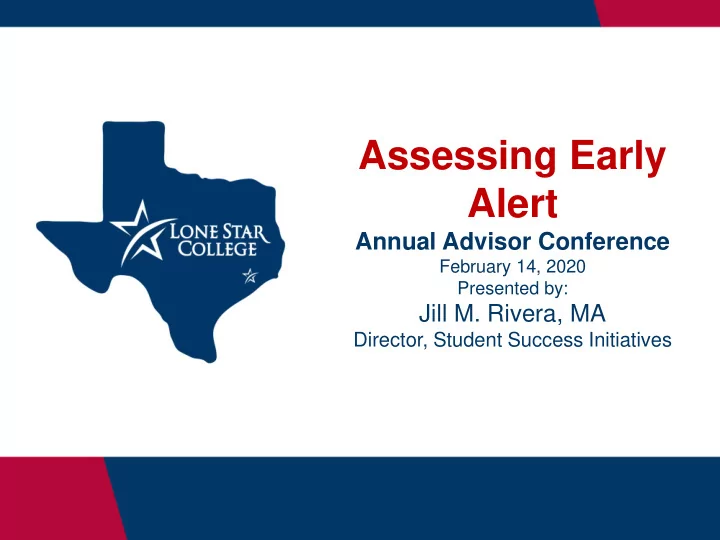

Assessing Early Alert Annual Advisor Conference February 14, 2020 Presented by: Jill M. Rivera, MA Director, Student Success Initiatives
WHAT IS EARLY ALERT? • The Early Alert program allows faculty and staff members to identify at-risk students and share that information with advisors and other student support staff on campus. • The goal is to help students get back on track academically by connecting students to support resources and to improve students’ motivation.
WHERE IT ALL BEGAN... • Prior to 2017: Campus specific with some effort to systemize (ex: Starfish) but we weren’t institutionally ready to commit to a system-wide Early Alert process. • Beginning in 2017: Faculty senate presidents expressed the need for a tool to alert advisors regarding at risk students. • North Harris had a form that was already in the student portal, which was then enhanced by tying it into iStar, adding some communication elements (emails) and data tracking. • Today: The Early Alert tool is in use, however, each campus has their own process.
WHERE WE ARE… • April 2019: Early Alert is added to the Pathways Action Plan: “Assess the Early Alert Program and make improvements as necessary” • November 2019 : Early Alert Team comprised of lead and key Early Alert personnel meets to discuss assessment plan. • December 2020 : Early Alert data (usage and outcomes) requested from AIR. Separate surveys developed for faculty and advisors/counselors. Campuses complete template outlining the process at their campus. • January 2020 : Early Alert data request fulfilled and Power BI dashboard is developed to provide data for ongoing assessment. • March 2020 : Surveys going out Faculty and Advisors/Counselors. • April 2020 : Assessment report will be complete and ready to share with stakeholders. • May 2020 and beyond : Begin implementation on agreed upon recommendations.
WHAT THE LITERATURE SAYS ABOUT EARLY ALERT SYSTEMS • Early Alert is consistently listed as a retention best practice along with FYE courses, supplemental instruction and tutoring, social integration, intrusive advising, and clearly mapped pathways to graduation. • Early alert systems may be most effective when targeting specific student populations such as remedial/developmental, educational opportunity (e.g. TRIO), international students, gateway courses, and students on academic probation or who are repeating a course. • Proper support systems, such as tutoring and advising, must be in place to follow through with identified students.
WE’VE GOT QUESTIONS…. • How many Early Alerts are being generated? • How do the students ultimately do in the class? • How many students get Early Alerts for multiple classes? • Do the students persist to the next semester? • What are the most common reasons for sending an Early Alert?
LET’S START WITH A LOOK AT THE NUMBERS…
ALERTS OVERALL • Student headcount is without duplicates. • Number of alerts indicates that some students received more than one alert. • Number is increasing every year.
BREAKDOWN BY CAMPUS • Increases every year with few exceptions.
WHAT ARE THE MOST COMMON ALERTS?
THE TOP 5 COURSES FOR EARLY ALERTS: • WITH FEW EXCEPTIONS, THE TOP 5 CLASSES ARE THE SAME YEAR AFTER YEAR. • TOP ALERT CLASSES ARE ALSO TRADITIONALLY FIRST SEMESTER/FIRST YEAR COURSES.
POST ALERT COURSE OUTCOMES: “COMPLETING VS. SUCCESSFULLY COMPLETING” *2019 FALL: 69% COMPLETED • 22% SUCCESSFUL (A-C) • 47% COMPLETED WITH D OR F • 31% WITHDREW
ALERTS BY MODALITY
AGE AND GENDER STATISTICS
RACE/ETHNICITY BREAKDOWN • ALERTS FOR HISPANIC STUDENTS IS INCREASING • ALERTS FOR WHITE STUDENTS IS LEVEL • ALERTS FOR BLACK STUDENTS HAS DECREASED
DO THEY COME BACK? • HALF OF THE STUDENTS WHO HAVE AN EARLY ALERT SUBMITTED ON THEIR BEHALF DO NOT RETURN THE FOLLOWING SEMESTER.
NOW WE’VE GOT MORE QUESTIONS… HOW CAN WE IMPROVE THE OUTCOME? • Do advisors and faculty feel that the tool is easy to use? • What is the ideal timing for an alert and should reminders be sent (e.g. 2 weeks, mid-term)? • Should we focus on specific student populations? • Would it help to add or remove anything from the Early Alert form? • What classroom interventions are made prior to alert? • Does the process provide for sufficient communication between faculty and advisor?
YOUR FEEDBACK IS NEEDED! • Right after spring break all faculty and advisors/counselors will receive a survey. • Survey specific to Faculty and Advisors/Counselors. • Please write in any other suggestions you have to improve retention through the Early Alert tool.
Thank you! If you have any questions, please feel free to reach out: Jill M. Rivera Director, Student Success Initiatives jill.rivera@lonestar.edu 832-813-6744
Recommend
More recommend